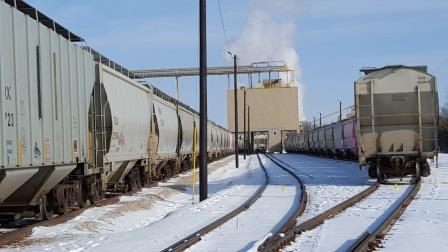Four-Cable Lifting Spout Reduces Wear, Backlashing
March 14, 2016

Fairmount Santrol is a global provider of industrial sand used in the foundry, gas and oil, glass, recreation, and filtration industries. Founded in 1986, Fairmount operations include mines, mineral processing plants, and coating facilities in North America, Europe, and Asia.
As a responsible corporate citizen, Fairmount is committed to employee health and safety management, protection of the environment, and product quality control. In 30 short years, Fairmont has evolved from a small silica sand producer to a major supplier of the world’s biggest industries.
During October 2014, Fairmount’s Wedron, IL plant broke ground on a plant expansion that included a major upgrade to the location’s rail-loading facility. The upgrade addresses the ability to load unit trains and includes three new rail loading bays, two of which are active and a third for future growth.
Kent Smith, project engineer at Wedron, was concerned about the retractable loading spouts that would be installed in the loading bays. “We had experienced maintenance issues with other manufacturers’ spouts in the past,” said Smith. “I did not want these issues present in the new facility.”
While discussing his concerns with a local manufacturers’ representative, the representative asked if Smith would be open to meeting with one of his principals, as they had a new spout design that might interest him. Smith gave the go ahead to schedule a meeting.
�
The representative set up a mid-July, 2014, meeting between Smith and Jon Jasinski, vice president of the Vortex Loading Systems division. Jasinski brought a loading spout and in-line filter with him to allow Smith to be able to view the Vortex design first hand. Smith was emphatic that a major goal was to eliminate the many problems they were experiencing with their current spouts – especially issues relating to frequent maintenance due to cable wear and breakage, also cable wrap issues when cables “jumped” the cable pulleys and loading had to be shut down while the cables were unraveled and rewound.
Vortex’s four-cable lifting design immediately caught Smith’s eye. Four cables contribute to better cable life and provide additional spout stability (spreading the load over four cables) compared to traditional two- or three-cable systems. The three-piece CNC machined cable pulleys contain radius edges and precision-sized grooves. They reduce cable wear and backlashing. Vortex’s idler rollers are forged and contain double sealed roller bearings. These are used instead of typical stamped rollers with bushings that can break. Combined, these three features allow Vortex to solve issues caused by problematic spout designs. Vortex offers a 10-year warranty on the listing cables.
Smith appreciated the Vortex innovations and the fact that Jasinski made a special trip with spouts in tow to make sure Smith fully understood what Vortex had to offer. His next question was, “Can Vortex supply our spouts with rotating positioners?”
If install room is available, a rotating positioner can offer a broader loading window than a standard single- or dual-direction positioner. A single direction positioner allows the operator to traverse the spout front to back over the vehicle (normally used when loading rail cars where the side to side position of the car is stationary). A dual-direction positioned allows the operator to traverse the spout front to back, as well as side to side over the vehicle (normally used when loading trucks where both positions will normally vary each time a truck parks to load). The fugitive material created during the loading process is vacuumed up the spout and through the hopper via a baffle within the hopper. It ends up in a dust collector.
In this case, the rotating positioner was engineered to allow each spout to precisely load at any point within a 12-ft radius. This type of positioner creates a much improved loading zone, while reducing the size of the support pan and traversing hopper. Jasinski assured Smith that a rotating positioner would be no problem.
“I was familiar with Vortex gates and diverters, as we utilize them at our facilities,” said Smith. “Although I was not at all familiar with the Vortex Loading Spout product line, I liked their features and was very satisfied with the information I received from Vortex. I felt this was a good opportunity to try a different product to see if we could achieve better success.”
An order was placed in October of 2014 for four Vortex loading spouts, each with a rotating positioner. Some additional engineering and electrical specifications were worked out while the building that would house the spouts was erected. Spouts were shipped the following June, and the facility began loading rail cars in January 2016.
Fairmount Santrol relies on its engineering staff to stay abreast of new product developments within the different market places in which it works. “From what I have observed, the Vortex design definitely addressed the issues we previously experienced with our loading spouts,” said Smith. “It was a good choice for us on this project.”
Kevin R. Peterson is business development director - Titan Products for Vortex, Salina, KS. For more information, visit www.vortexvalves.com.
Get more information or register for the International Powder & Bulk Solids Conference & Exhibition, May 3-5, 2016
For related articles, news, and equipment reviews, visit our Material Handling & Transportation Equipment Zone
Click here for a List of Material Handling & Transportation Equipment Manufacturers
You May Also Like


